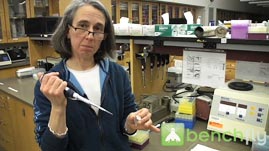Teachers' Domain - Digital Media for the Classroom and Professional Development
User: Preview




Pipetting very small volumes of liquid requires both accuracy and precision. As this video from BenchFly.com demonstrates, one technique for dispensing particularly small volumes is to deposit the liquid directly on the inside wall of the receptacle.
Pipettes and micropipettes are laboratory instruments designed to measure and dispense small volumes of liquid—often volumes much smaller than a single drop. When used properly, these devices can deliver a volume of liquid to the nearest microliter, or one-thousandth of a milliliter.
Both accuracy and precision are important when working with particularly small volumes, as even tiny errors can have significant consequences. For example, adding too much of a particular chemical or solution might keep a necessary reaction from taking place, or might cause a reaction to move much more quickly than intended. Also, DNA and protein samples commonly used in biotech labs are expensive and come in small volumes, so it is important not to waste them.
The smaller the volumes, the more critical it is that pipette measurements be both accurate and precise. Accuracy refers to the difference between the desired volume and the actual volume dispensed, while precision refers to the ability to reproduce consistent, reliable measurements.
Using well-established techniques can help scientists and technicians ensure both accuracy and precision in their measurements. However, working with the smallest volumes can present challenges even when the most basic pipetting techniques are followed.
For example, when dispensing only a few microliters, the solution or sample might cling to the micropipette tip. Dragging the tip along the inside wall of the receptacle will ensure that the full amount measured by the pipette is dispensed. This technique can be used with multiple liquids along different parts of the tube's inside wall. Then, once all liquids have been dispensed and the container sealed, a quick flick of the tube followed by a short spin in a centrifuge will combine even the tiniest volumes in the bottom of the tube.
 Loading Standards
Loading Standards